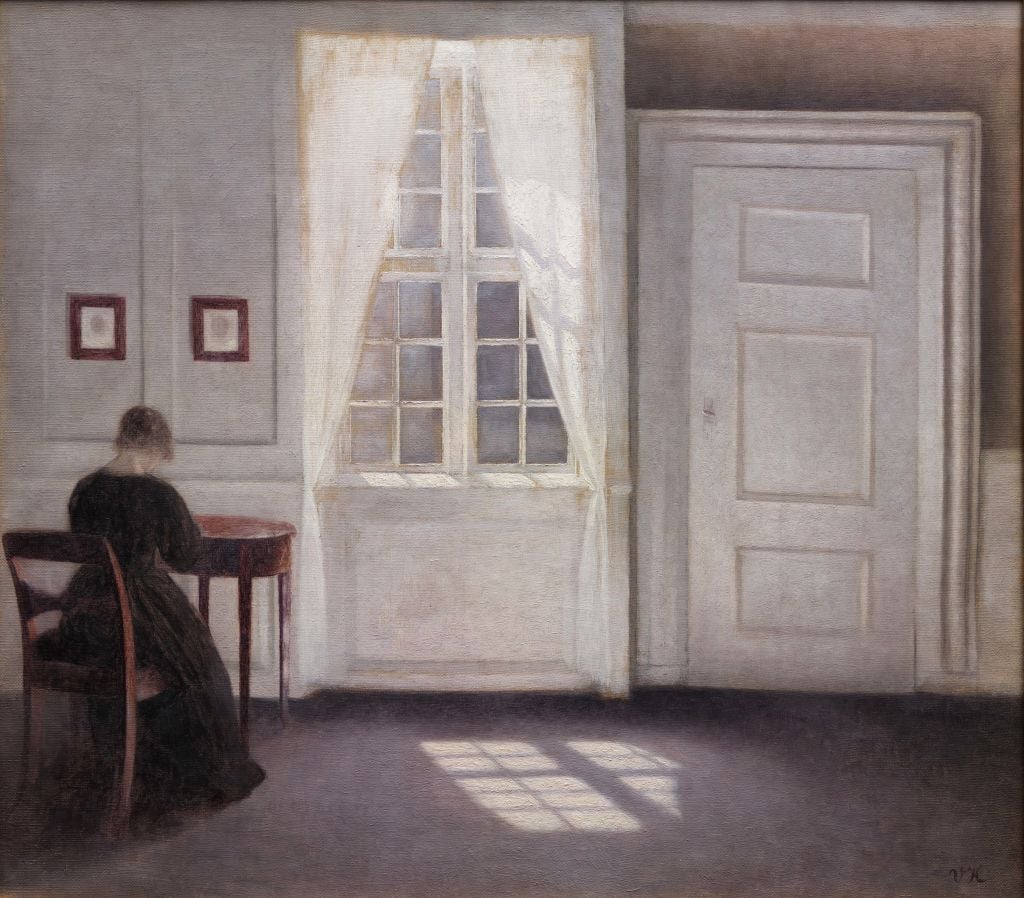
Vilhelm Hammershøi is one of the most famous and sought-after Danish artists of all time.
Born in 1864 in Copenhagen, he is remembered for his paintings of largely empty rooms with a tenor alternating between the calm and the melancholic—an impression that served as a precursor for American artist Edward Hopper. In truth, though, Hammershøi has more in common with Dutch Golden Age painters like Johannes Vermeer or Pieter de Hooch, who, unlike Hopper, usually painted their pictures from the inside looking out, rather than the outside looking in.
Like Vermeer and De Hooch, Hammershøi often included a single female figure in his scenes. But where the Dutch masters typically showed the faces of these women, allowing the viewer to read their emotional states and identify with them, Hammershøi exclusively painted his female figures from the back, leaving their identity a mystery.
Vilhelm Hammershøi, Interior (c. 1910). Photo: Fine Art Images/Heritage Images/Getty Images.
It turns out that the model for these faceless women was none other than Hammershøi’s wife and lifelong partner, Ida. Although the the couple was rather shy and introverted, leaving behind few details of their private life, we have a rough idea of what their relationship was like.
Born to a wealthy merchant family from Copenhagen, Ida Hammershøi (née Ilsted) married the painter in 1891. In a letter written to his mother that same year, Hammershøi suggests they became husband and wife to help Ida escape her family, writing that her “mother is once again as mad—to put it bluntly—as she can be.” To celebrate their engagement, Hammershøi painted a portrait of his fiancée—one of the few times he actually depicted her face.
Vilhelm Hammershøi, The Artist’s Wife, Ida Hammershøi, née Ilsted (1894). Photo: Heritage Art/Heritage Images via Getty Images.
Although Hammershøi traveled across Europe for his work and studies, passing through Paris, Munich, London, and Rome, the couple spent the vast majority of their time in Denmark, where they lived in more or less perpetual self-isolation.
If the Hammershøis avoided contact with the outside world, they appear to have tolerated one another. “They looked so nice and homey and a little lost,” the author and poet Johannes Jorgensen recalled in an article written for a Danish newspaper, “the two Danes, as they stood there reading the sign on a street corner.”
“Vilhelm and Ida form a rare and beautiful unity,” agreed Jesper Wung-Sung, author of Kvinde set fra ryggen (Woman Seen From the Back), a 2021 novel that offers a semi-fictional account of Ida’s mysterious life. “Unlike many other artists, Vilhelm never leaves her, never travels alone… Ida is with him everywhere—it is unheard of for a couple to be together 24/7 at that time.”
One of the few things we know about the couple is their homeownership. For most of their marriage, they lived in Copenhagen’s Christianshavn district, initially at Strangade 30 and later, in 1909, at Strangade 25, a minute distance that speaks to their hermetic lifestyle. We know this not just from public documents, but also from Hammershøi’s paintings, the vast majority of which he painted indoors.
Ironically, we know more about Ida’s estranged mother than we do about Ida herself. Records in Denmark’s Royal Library reveal that she was diagnosed with “hysteria,” that “doctors in the mental hospital noted… she was ‘clever’ but ‘bad-tempered,’” and that “she had several times discharged herself against the hospital’s recommendation.”
Hammershøi painted his last picture of Ida in 1907, when she was suffering from nervous shock after the two were arrested on a trip to Rome for unwittingly using counterfeit money.
Vilhelm Hammershøi, Ida Hammershøi, the Artist’s Wife, with a Teacup (1907). Photo: Heritage Art/Heritage Images via Getty Images.
Although there is almost no information about what happened to Ida after her husband died in 1916, we do know that she outlived the painter by more than three decades. Unfortunately, neither lived to see Hammershøi’s paintings gain the popularity they have today, which didn’t start happening until the 1980s and ’90s. (Four of his paintings have fetched north of $5 million at auction since 2017, according to the Artnet Price Database; his Interior. The Music Room, Strandgade 30 far outstripped its $5 million high estimate at Sotheby’s New York in 2023, selling for $9.1 million, his current auction high.)
The circumstances of Ida’s own death, in 1949, remain a mystery. While some believe she died of illness, others, like Wung-Sung, believe her death was closer to suicide, as she refused to seek treatment.
“Hammershøi is not one of those about whom one can speak quickly,” the poet Rainer Maria Rilke wrote of the painter. “His work is wide-ranging and slow, and at whatever moment one comprehends it, it will always provide an opportunity to talk about what is important and essential in art.”
What’s the deal with Leonardo’s harpsichord-viola? Why were Impressionists obsessed with the color purple? Art Bites brings you a surprising fact, lesser-known anecdote, or curious event from art history.